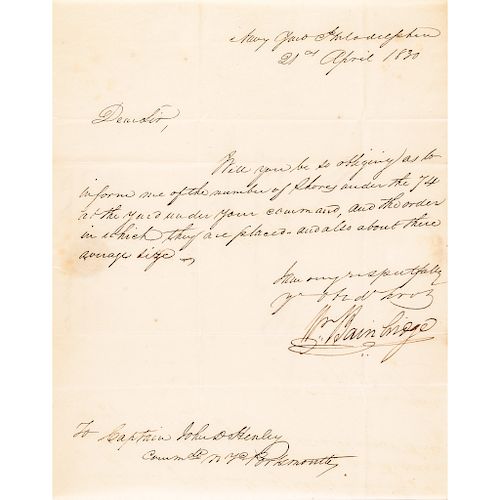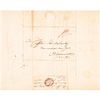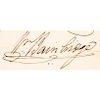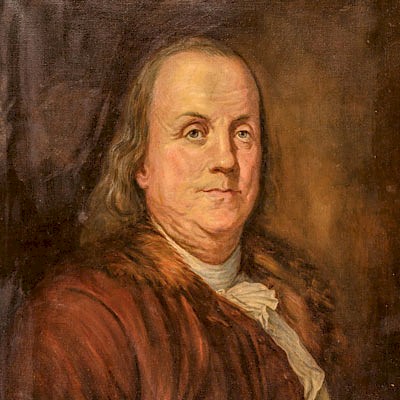Commodore WILLIAM BAINBRIDGE Commander Frigate USS Constitution 1830 Navy Letter
Lot 2
Estimate:
$600 - $1,000
Absentee vs Live bid
Two ways to bid:
- Leave a max absentee bid and the platform will bid on your behalf up to your maximum bid during the live auction.
- Bid live during the auction and your bids will be submitted real-time to the auctioneer.
Bid Increments
| Price | Bid Increment |
|---|---|
| $0 | $10 |
| $200 | $20 |
| $300 | $25 |
| $500 | $50 |
| $1,000 | $100 |
| $2,000 | $200 |
| $3,000 | $250 |
| $5,000 | $500 |
| $10,000 | $1,000 |
| $20,000 | $2,000 |
| $30,000 | $2,500 |
| $50,000 | $5,000 |
| $100,000 | $10,000 |
| $200,000 | $20,000 |
| $300,000 | $25,000 |
| $500,000 | $50,000 |
About Auction
By Early American History Auctions
Aug 24, 2019
Set Reminder
2019-08-24 12:00:00
2019-08-24 12:00:00
America/New_York
Bidsquare
Bidsquare : Autographs, Colonial Currency, Political Americana, Historic Guns
https://www.bidsquare.com/auctions/early-american-history-auctions/autographs-colonial-currency-political-americana-historic-guns-4347
Historic Autographs • Colonial Currency • American Civil War Colonial Era • Revolutionary War • Political Americana • Black History Early American History Auctions auctions@earlyamerican.com
Historic Autographs • Colonial Currency • American Civil War Colonial Era • Revolutionary War • Political Americana • Black History Early American History Auctions auctions@earlyamerican.com
- Lot Description
Autographs
1830 Commodore William Bainbridge "USS Constitution" Commander the 44-Gun Frigate Autograph Signed Letter
WILLIAM BAINBRIDGE, (1774 - 1835). Commodore in the United States Navy, notable for his victory over the British Warship "HMS Java" during the War of 1812 while commanding the 44-gun Frigate "USS Constitution," in succession to Captain Isaac Hull.
April 21st, 1830-Dated, Autograph Letter Signed, "Wm. Bainbridge," 1 written page of 4 pages with Integral Postal Transmittal Cover, Choice Extremely Fine. This original letter is dated 1830 at the Philadelphia Navy Yard. William Bainbridge's letter is to Captain John Henly of the Portsmouth Naval Yard, regarding the number and size of shores (device to hold items up) at the yard, the number, order and size. Boldly Signed, "Wm Bainbridge" in rich deep brown ink on fine quality clean period wove paper. Red Postal manuscript "18" and round red cancel, "PHILA - 21 - APR." An impressive well written and quite lovely, American naval ALS by Bainbridge, who's bold signature measures a large 3 inches long at its conclusion.
William Bainbridge (May 7, 1774 - July 27, 1833) was a Commodore in the United States Navy, notable for his victory over HMS Java during the War of 1812.
When the War of 1812 broke out between the United Kingdom and the United States, Bainbridge was appointed to command the 44-gun frigate USS Constitution, in succession to Captain Isaac Hull
On 29 December 1812 he fell in with the 38-gun HMS Java, a vessel of 1,083 tons, formerly the French frigate Renomme. She was on her way to the East Indies, carrying the newly appointed lieutenant-governor of Bombay. She had a very inexperienced crew, including very few trained seamen, and her men had only had one day's gunnery drill. The United States Navy paid great attention to its gunnery, which some captains in the British Navy had neglected, having grown accustomed to easy victories over the French or lacking the time and resources for gunnery practice. In these conditions, the fate of the Java was soon sealed. She was cut to pieces and forced to surrender, after suffering heavy losses, and inflicting very little damage to the Constitution, other than removing Constitution's helm with a well-aimed shot. During the action, Bainbridge was wounded twice, but maintained command throughout; even to replacing the missing helm on the Constitution with the one from the Java before she sank. To this day, the still-commissioned Constitution (anchored in Boston Harbor) sports the helm that Bainbridge salvaged from the Java.
After the conclusion of the war with Britain, Bainbridge served against the Barbary pirates in the Second Barbary War.
In 1820, Bainbridge served as second for Stephen Decatur in the duel that cost Decatur his life. Bainbridge had actually harbored a long-standing jealousy of Decatur.
Between 1824 and 1827, he served on the Board of Navy Commissioners. He died in Philadelphia and was buried at the Christ Church Burial Ground in Philadelphia.
John D. Henley, brother of Captain Robert Henley, who was born in Williamsburg 25 February 1781. Commissioned midshipman 14 August 1799, Henley served in Chesapeake cruising in the West Indies until 1801. Departing Baltimore in the schooner Vixen 3 August 1803, he joined the Mediterranean Squadron for the AVar with Tripoli. An officer in Gunboat No. 6 under Lieutenant John Trippe, Henley participated in the attack on Tripoli 3 August 1804. Gunboat No. 6 ran alongside one of the enemy's large boats and nine men and two officers, Trippe and Henley, stormed the Tripolitan before the gunboat fell away from the enemy. Although outnumbered three to one, the Americans fought so fiercely that within a few minutes the enemy struck their colors. Fourteen of the enemy had been killed and 22 were taken prisoner. Both Trippe and Henley were highly commended for their bravery in this action. Following completion of his tour in the Mediterranean in 1805, Henley made a merchant voyage to distant ports and then in September 1807, assumed command of Gunboat No. 20.
Henley then served a tour in Washington and with the outbreak of war against the British was ordered to Charleston in June 1813 to command schooner Carolina. His ship was destroyed 27 December 1814 off New Orleans during a fierce struggle in which the few small warships played a decisive role in delaying the powerful British attack and bringing victory. For his part in the victory at New Orleans 8 January 1815 Henley was highly commended by General Andrew Jackson. Promoted to Captain 5 March 1817, Henley commanded John Adams in the West Indies and Congress in the Indian Ocean before taking command of Macedonian in the struggle against West Indian pirates in 1822. Captain Henley served as commandant of the Charleston and Baltimore stations an dthe Portsmouth Navy Yard, New Hampshire, 1826 to 1832. On 16 August 1832 he was given command of the West India Squadron with Vandalia as his flagship. Captain Henley died on board Vandalia in Havana, Cuba, 23 May 1835.
- Shipping Info
-
Early American provides in-house worldwide shipping. Please contact us directly if you have questions about your specific shipping requirements.
-
- Buyer's Premium



 EUR
EUR CAD
CAD AUD
AUD GBP
GBP MXN
MXN HKD
HKD CNY
CNY MYR
MYR SEK
SEK SGD
SGD CHF
CHF THB
THB













